#i also enjoy trying to figure out what the most ''iconic'' item/block of each season is
Text
been trying to think abt compressing the life series -> figuring out exactly what defines each season, eg tone, themes, reoccurrences, etc. figure out exactly what makes each one distinct and explain it as simply as possible. it's awesome but also Not easy
#i also enjoy trying to figure out what the most ''iconic'' item/block of each season is#so far i've got 3l = banners. ll = wither skulls. dl = goat horns? liml = tnt minecarts. and sl isn't over yet#i say ''iconic'' but moreso i mean like. what's a recurring item that seems to reflect the values of the season#idk. i still want to be able to make a big teardown post about 3rd life one day. but i need to work on ripping it apart first#which is gonna require a lot of going Back To Basics of defining the tone n stuff#i guess it's like. if you had one sentence to tell a story. what would you choose to say
18 notes
·
View notes
Link
Mardi Gras parades got canceled by Covid-19. So New Orleanians turned their houses into floats Like so many, the mom and insurance manager had known in her gut that the weekslong fête would take 2021 off. Revelers of all ages packed at least three deep along routes that wind for miles seemed the textbook antithesis of social distancing. “So, I kinda made a comment: ‘Well, that’s fine, I’m just going to decorate my house,'” said Boudreaux, who invited her neighbors to turn their homes, too, into stationary versions of the ornately designed floats that populate the four dozen or so parades that roll in the city each year. This way, she figured, partiers could stay 6 feet apart while visiting outdoors and enjoying the artistry of the annual countdown to Lent. The idea, like a splay of bead strands hurled skyward toward an endless carousing crowd, has spread. There’s a home with a sign that beckons, “Welcome to Wakanda.” Another features a Night Tripper theme in homage to funkman Dr. John. One house honors a health care worker alongside giant ivory beads. On a balcony, a cutout of the late chef Leah Chase stands, spoon in hand, at an enormous pot. Just off the St. Charles Avenue streetcar line, a giant model dinosaur in a top hat grazes. Elsewhere, a set-up pays tribute to Alex Trebek with a “Jeopardy!” board, playable using a posted QR code. Human-size Lego figures approximate a float rolling by parade-goers on a front porch. A wooden pelican the width of two men perches at another. All across town, papier-mache or cardboard and foil flowers of every hue, plus bunting of purple, green and gold and strands of beads the size of beach balls, adorn the homes where so many have been in retreat from the coronavirus since just after last Mardi Gras. That’s when 1.5 million people — including international visitors — converged on the city, almost certainly fueling viral spread that made the region an early hot spot. Indeed, the purple-and-white house icons that dot a map on the Krewe of Float Houses website cover the city’s entire main footprint like a sidewalk littered with doubloons, those collectible metallic coins tossed by riders from traditional floats. “In its essence, it’s not much different than when people drive around with the kids in the car and look at the Christmas decorations, holiday lights,” said Doug MacCash, who’s chronicled the house float movement for the local newspaper, The Times-Picayune | The New Orleans Advocate. “Except this year, in 2021, it has such a spirit of triumph, such a spirit of defiance. It’s like, ‘Sorry, ‘rona. We’re not just giving up.'” “Mardi Gras by no means is dead; it’s just different,” said City Councilman Jay Banks, who’s cast his own house — already painted yellow and black — with other trademark representations of the Zulu Social Aid & Pleasure Club, the city’s preeminent Black Carnival organization, over which he once reigned as king. “And what we’re forced to do this Mardi Gras, with Covid as the No. 1 consideration, … is how this whole house float thing got started,” he said. “And let me tell you, I am just giggly about it.” How to turn your house into a float Do-it-yourselfers — many already armed with hot-glue guns and glitter by the gallon for crafting annual Mardi Gras costumes — have embraced the home-design effort in earnest. Two private Facebook groups with more than 14,000 participants spew inquiries at all hours, most swiftly answered by a hive mind eager to collaborate after months of stay-at-home orders. “Any recommendations on securing this? It’s top heavy,” one poster asked, referring to a photo of a homemade Lysol can prop standing several feet tall. From another: “Has anyone had luck with using cardboard to make house float decorations? I already used some and painted and sealed with mod podge acrylic sealer but am wondering how it will hold up in the elements on a French Quarter balcony! Is there a better way of waterproofing, etc.?” The exchange is not unlike in the bleak months after Hurricane Katrina in 2005, when neighbors connected to trade recipes for bleach or baking soda concoctions to remove mold from items soiled by the flood. Others looking now to gild their homes have turned to a regional cottage industry built over decades for precisely this sort of venture. “Part of the consternation about canceling Carnival had to do with, well, there are people (for) who(m) Carnival is their livelihood — a lot of people: float builders, bead- and costume-makers,” MacCash said. “Some of the Carnival artists who find themselves out of work at what would have been a real scrambling sort of time, what they’ve done is they’ve found employment decorating houses.” In a normal year, René Pierre right about now would be finalizing the books on some 75 floats that his company, Crescent City Artists LLC, decorates using lightweight utility canvas, bright house paints, hard coating, wood and Styrofoam, he said. This year, Boudreaux’s house float vision, which Pierre caught on a local news report, proved to be his “ticket out” of a toned-down Carnival — and one that follows his and his young daughter’s recovery from Covid-19. “Oh, man, in about three weeks, we were booked all the way up until today,” Pierre said last week of his house-decorating customers. “My wife and I were trying to sleep one night, and we kept hearing notifications coming from the website. It was like, “Ping ping ping ping ping.’ It was like, ‘Oh, my God.’ It was like instant success. It was incredible.” The couple inked 53 house float contracts ranging from $1,500 to $3,000 apiece, a sum many riders in the city’s biggest parading groups typically would spend on bead strands and other “throws” to toss in a given year. “It has really pumped my business into full steam,” Pierre said, noting he hired his cousin, a recording artist, to help manage the crush. “We have made more money in six weeks … and talk about Mardi Gras spirit.” Of the commissions, Pierre’s favorites are a trio of painted pups fashioned after the homeowner’s own pack, a Buddha-themed display and one highlighting the Grateful Dead dancing bears. Boudreaux, known as “Admiral B” of the house float fleet, aptly did her house in a maritime motif. “I don’t know if I want to know how much I spent,” she said: “definitely more than I meant to, less than a lot of people.” How to lead (or join) a house float krewe Beyond her own decor, helming this nascent krewe (local vernacular for a festival group) has become a second full-time job for Boudreaux. There are exchanges with lawyers over decorating rules in historic districts and weekly logistics meetings with the mayor to game out how to handle homeowners who want to, say, hire a band. There are now 50 captains, 39 subkrewes, a communications team and an effort to gather and edit together dozens of dancers’ at-home videos into a performance masterpiece for the website. Yet another to-do list item got added shortly after the krewe named a New Orleans bounce star as its grand marshal, Boudreaux said. “Now Big Freedia’s house is a traffic jam. The house is so popular that even guerilla photograph-style, it still drew a crowd,” the one thing the Krewe of House Floats wants urgently to prevent. The krewe also has launched a campaign to donate $100,000 toward those facing unemployment and food and housing insecurity largely because of this year’s Carnival limits: artisans, service industry workers, musicians, Mardi Gras Indians and other culture-bearers. And, perhaps unsurprisingly, “this year plants the seed” for what’s already becoming an annual event, to endure long after the coronavirus is vanquished, MacCash said. (At last count, Pierre already had 28 house-decorating contracts set for 2022, and preregistration is open for next year’s Krewe of House Floats.) For now, Chris Volion is looking forward to safely welcoming on Fat Tuesday, February 16, revelers who pass by his New Orleans home, adorned with enormous black birds inspired by local crows and Edgar Allen Poe in his personal Krewe of Nevermore. Volion, an institutional research analyst, and his wife, Janet, are making some themed throws to hand out and plan to join neighbors for king cake-flavored Jell-O shots. “While it feels different, there’s still that excitement going on,” he said. This year, instead of swapping parade plans, “the conversation has shifted to: Have you been to such and such a block, or have you see this house? It’s so beautiful to see that the energy is still there.” For Banks, the city councilman, the house floats offer a glimmer in an especially bleak season. In his own circle, Covid-19 has taken 23 lives and killed 17 members of the Zulu organization, he said, not to mention relatives and friends of the club. It’s stripped New Orleans — and the world — of the chance to socialize in person and to observe customs in the typical way. But as is so often the case, he said, the city’s response in this dark moment offers a message far beyond its borders. “We’re showing the rest of you that there is light at the end of the tunnel,” Banks said. “As screwed-up as Covid is, we will not let it defeat us. … The lesson of New Orleans for the world is: You play the cards that you’re dealt.” Source link Orbem News #Canceled #Covid19 #floats #Gras #houses #Mardi #MardiGrasparadesgotcanceledbyCovid-19.So #NewOrleaniansturnedtheirhousesintofloats-CNN #Orleanians #parades #turned #us
0 notes
Text
MA Fashion and Textile Practices Major Project Path - 30th August
Straight after the programme Bauhaus 100 there was another Design Season programme called Bauhaus Rules with Vic Reeves. I love Vic Reeves (Jim Moir) so thought it could be an interesting watch. With 2019 marking the 100th anniversary of Bauhaus, BBC Four took the cameras to London’s Central Saint Martins to see if current students at the art school could live by the rules of Bauhaus for a week. Accompanying them was the shows presenter celebrity comedian Vic Reeves. Six graduates of the school were asked to participate in the Bauhaus takeover experiment, whose disciplines ranged from fine art, fashion, graphic design and architecture. Each day they would be presented with a creative brief inspired by the Bauhaus workshops, to see if the power of Bauhaus still holds true today. On the Saturday they would be holding a Bauhaus inspired costume party and were told to ask anybody who was up for it to come along.
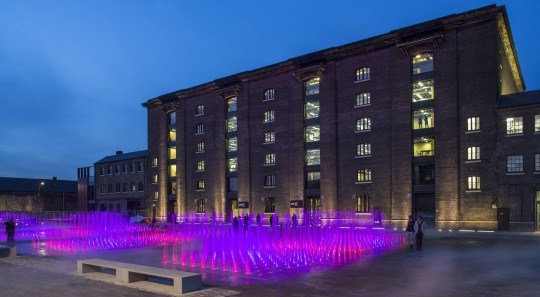
Linkedin, n.d. (n.d). Central Saint Martins, University of The Arts London. [Photograph]. Retrieved from https://www.linkedin.com/company/central-saint-martins-college-of-art-and-design-university-of-the-arts-london/.
Setting the briefs for the graduates were keys figures from art and design - the first of which was artist Ian Whittlesea, who had studied the exercise regimen devised by Bauhaus Master Johannes Itten. The graduates were took to the roof of the school and followed a set of exercises delivered by Whittlesea. The graduates could see the point of these mind clearing exercises, one ex student Lisa Darrer (2019) said it made her feel really grounded and aware of her surroundings, another ex student - Lizzy Deacon (2019) said she felt very aware of her body and noticed one of her hands was bigger than the other. The exercises really seemed to make an impact on the students as a whole, making themselves more aware of themselves and their surroundings.

The Art Story, n.d. (n.d). Itten leading his students in physical exercises. [Photograph]. Retrieved from https://www.theartstory.org/artist/itten-johannes/.
They were then taken to the canteen where they were given a meal of bread and a recipe of Itten’s creation - ‘garlic mush’, which some of them enjoyed as they said it was probably healthier and better for them than some of the meals they had been eating as students!
Ian then set the graduates their first creative brief, they were to explore the contrast between basic materials such as rough and smooth, hard and soft,light and dark etc. and to make a piece of art from it - this reminded me of Marcel Duchamp and his found art or ‘Readymade’s’. All the students materials were to come from the ground or from the bins of the school. This exercise in discovering the most basic of materials was part of the preliminary course at Bauhaus and was to help the students see the usefulness and beauty in everyday objects. I remember doing a similar exercise whilst studying for my degree in Graphic Design, except it was to show contrasts between fonts.

Mirkin, M. (1922). Contrast Study with Different Materials (Reconstruction 1967). [Mixed Media]. Retrieved from https://www.pinterest.co.uk/pin/279152876885423902/?lp=true.
The graduates were then asked to blindfold themselves to feel the objects they had found, this was also one of Itten’s ideas, that to create something the students must engage with all their senses and discover their sense of ‘play’. They were then given an hour and a half to produce their pieces. It was a good exercise for the graduates, they said it was like they were relearning and rediscovering materials they would have otherwise ignored.
The next brief was to echo Wassily Kandinsky’s colour theory practice. To set this brief was Scottish artist David Batchelor - whose installations use colour and geometry in a similar way. He gave each of the graduates a piece of paper which showed a line drawing of a circle, triangle and square. They then had to assign the three primary colours given to each of the shapes - red, yellow and blue. He wanted them to consider carefully each shape and colour and try to ‘feel’ which colour went with which shape - under Kandinsky’s rule there is only one correct answer!
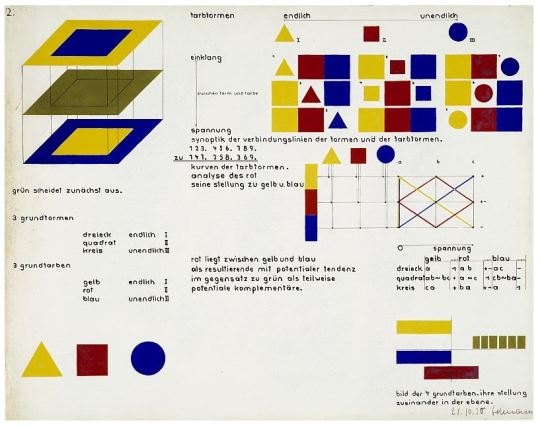
Bormann, H.S. (1930). Heinrich-Siegfried Bormann, Illustration of the four primary colours: their planar relation to each other (study from Kandinsky’s course), 1930. [Illustration]. Retrieved from https://www.vmbee.com/blogvmb/2016/3/22/bauh.

Bayer, H. (1968). 50 Jahre Bauhaus. [Poster]. Retrieved from http://www.artnet.com/artists/herbert-bayer/50-jahre-bauhaus-poster-C1hxUHTljHkT8CPbW1MJyg2.
The answer was of course illustrated in the study of the theory by one of Kandinsky’s students Heinrich-Siegfried Bormann and in the above poster by Herbert Bayer. According to Kandinsky’s Basic Colour Theory he determined that the triangle was an interesting shape so it deserved a energetic and lively colour such as yellow. The square was of some interest so would suit a strong colour such as red, and the circle being a ‘dull’ shape required the colour blue which was a peaceful colour. Only Vic Reeves and one other graduate passed the test. They said they felt drawn to use yellow for the triangle as it felt like an unsettling colour, interesting! That is pretty much how Kandinsky would describe the colour. David then set them a task to use only three primary colours and the three basic shapes to create a piece of art, or whatever they wanted. David (2019) made an interesting comment in regards to Kandinsky’s method of using intrinsic methods:
“It all sounds pretty wacky today, but immediately after the first world war - a world which appears to be falling apart - and they’re just trying to stick it back together again in a new way”
It was true that Gropius had set up the Bauhaus school to find a new way of thinking after the horrors of the war. They were grasping at ideas and running with them. It was same as the graduates in the documentary, some of them decided to abandon his method and go with whatever idea they had, not agreeing with the rigidity it set - sometimes it is all about breaking the rules!
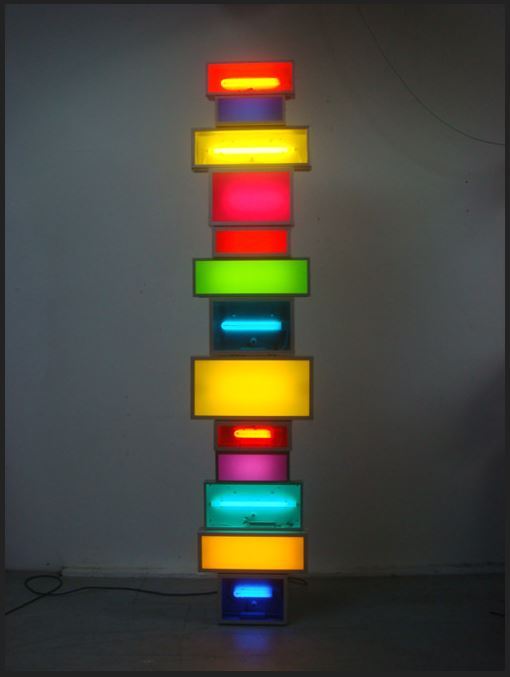
Batchelor, D. (2013). Spectotem 6. [Installation]. Retrieved from https://curiator.com/art/david-batchelor/spectotem-6.
The next to offer up a brief was head of design at Habitat Kate Butler. She first discussed Marcel Breuer’s iconic Wassily Chair. Made from tubular steel and inspired by the artists Adler bicycle handlebars, it was the start of what was to become tubular steel furniture. The process for creating tubular steel had only just come onto the market and produced by German steel manufacturer Mannesmann. Breuer took this idea and adapted it to fit his furniture concepts. The designs were revolutionary at the time, using bent tubular steel and materials such as leather had never been done before.

Breuer, M. (1925). Marcel Breuer Wassily Chair. [Furniture]. Retrieved from https://kaiyo.com/knoll-knoll-marcel-breuer-wassily-chair/.
The graduates were taken to the metal workshop and given the task of making an everyday household item using the Bauhaus principles of form follows function, and were split into pairs to collaborate their ideas. At Bauhaus it was commonly believed that women couldn’t think in 3D, which is preposterous but at the time women were still regarded as less creative. The graduates were given one hour to sketch up their preliminary ideas and then it was down to them, with the help of the metal workshop technicians, to come up with a viable item. They actually came up with some great ideas, one was for a portable birdbath - and in their words clearly something every millennial would need! One idea was for a seat for your dog at the table, another for a simple cafetiere. They determined that the collaboration was a great way of sharing ideas, and really enjoyed the experience of bouncing ideas off each other.
The next brief was set by experimental photographer Constanza Isaza Martinez, who asked the graduates to produce a photograph without the aid of a camera.This was taking direct inspiration from artist and Bauhaus Master László Moholy-Nagy who pioneered a technique of producing photographs - or photogram’s as he called them by the means of photo sensitive paper. Constanza asked the graduates to make these photographs using light and shade for inspiration. The had a while to plan their designs and then went to the schools dark room with any materials they wished to use, they had to bear in mind that anything they blocked out from the paper would appear white on their designs.

Moholy-Nagy, L. (1925/1928). Photogram. [Photogram]. Retrieved from http://artsatva.com/moholy-nagy-future-present/ex8059_312_mnf_004-hpr/.
The designs turned out really well for the graduates. They experimented with lots of different materials and the results reflected that. Some were quite playful, which was Moholy-Nagy’s idea, that it was about discovering what materials could do when under certain circumstances. They found the experiment to be beneficial in the way they may now look at the materials they use for their own projects, the beauty that can be found in everyday materials.
The next brief was set by graphic designer Neville Brody, who made his name by designing graphics and layouts for iconic magazine The Face. The task was to design a poster for Saturday’s costume party and the theme was metal - a nod to the iconic metal themed party held by Bauhaus Dessau - but incorporating attention seeking graphics, not mixing upper case and lower case fonts and to include a made up language. The graduates had a certain amount of time to sketch up their ideas and then were taken to the Letterpress workshop to be instructed by specialist technician Helen Ingham. Bauhaus really set the way for advancements in typography and graphic design, they broke the rules in typography and layout in the way it was used, breaking free from a fussy Victorian aesthetic. Herbert Bayer was head of printing and advertising at Bauhaus Dessau and was responsible for creating much of the schools advertising, posters and literature. His method of using fonts sans serif - without any embellishment on the typeface - was to become the contemporary style to take over typography at that point in time. Bauhaus very much set the tone for directional graphic design for the next century and many influences are commonplace today.
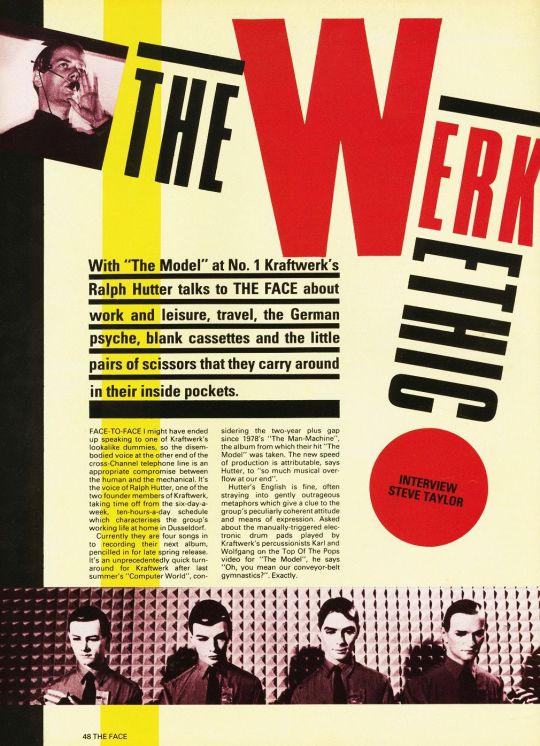
Brody, N. (1980). NEVILLE BRODY. The Face. Magazine, inside. 1980s.. [Editorial]. Retrieved from https://www.pinterest.co.uk/pin/461407924312729098/?lp=true.
The students at Bauhaus often used a process called ‘Photomontage’ which took images from various sources and mixed them together in a collage type manner, this was considered very cutting edge. The graduates approached the poster design in a similar manner and combined photocopying, metal objects and letterpress to create their collaborative piece. They were asked to select their three favourite designs and Neville Brody then selected the winner. It was interesting as the brief asked that the design be attention grabbing, and the completed designs were all in black, white and red - as my Anarchist of Love T-shirt and very much in the style of the ‘red topped’ daily newspapers I mentioned previously. Maybe the graduates had subconsciously tapped into that, that the colours and images used were attention grabbing like those daily newspapers were intended to be. Helen Ingham (2019) described the finished design as ‘quite punk’.

The last brief was delivered by fashion designer Holly Fulton who set the graduates the task of designing their own costumes for Saturday’s metal themed costume party as well as decorate the gallery space at Central Saint Martins. They had to be inspired by the costumes of artist and choreographer Oskar Schlemmer, who ran the Bauhaus theatre group. They were encouraged to think big, she wanted to see unique and interesting shapes emerging, Bauhaus was all about uniqueness. She said at the party they would have to pair up and involve themselves in the ‘Bauhaus Dance’ - which involved dancing in pairs without touching, but the wild stamping of feet and leaping in the air were highly encouraged! The graduates some up with a sub theme of ‘opposites attract’ like a magnet would attract, so worked this into their Bauhaus dance by incorporating dance moves which mirrored each other.
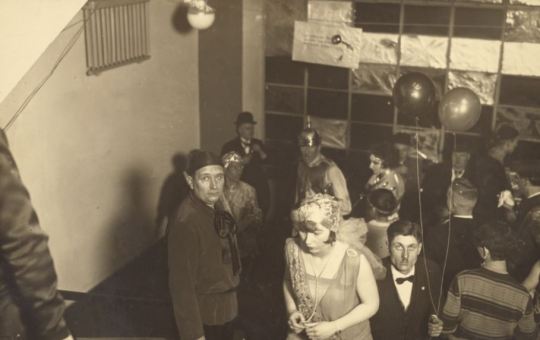
Binnmann, R. (1929). Metallisches Fest. [Photograph]. Retrieved from http://www.getty.edu/art/collection/objects/57672/rudolph-binnemann-metallisches-fest-german-about-1929/.
The graduates were given some metal objects to start them off and then quickly realised a trip to the shops was needed to gather more materials. The found hardware stores and the kitchen departments of interiors shops were the best places, and returned with a huge selection of goodies to inspire their designs. Costume parties at Bauhaus were highly competitive, it was all about who was the most avant garde and different. The graduates costumes were a huge success and really portrayed the Bauhaus spirit of experimentation and collaboration. If it wasn’t for the Bauhaus we may never of entertained the collaborative culture in the way we have, and still continue to do.
Vic Reeves had designed himself a metallic cyclops horse costume, which was certainly unique! He surely must have been inspired by the Bauhaus sense of experimentation. His comedy has always erred to the side of the avant garde, and was one of the pioneers of the alternative comedy scene. The Bauhaus parties were special to Walter Gropius, that when he died in in Boston, Massachusetts in 1969 at his request a metal themed ‘Fiesta a la Bauhaus’ party was held with ‘drinking, dancing, laughing and loving’.....very apt.
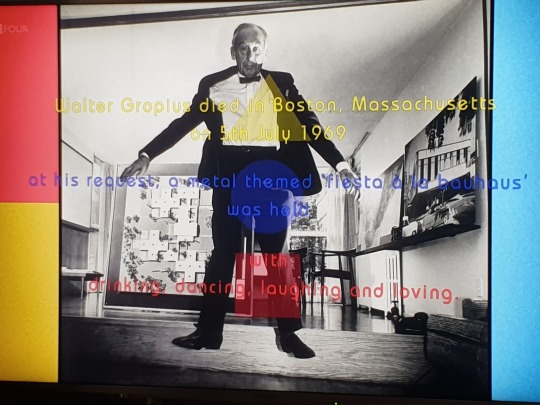
Websites:
Smirnova, E. (n.d). Basic Color Theory by Kandinsky. Retrieved from https://ekaterinasmirnova.wordpress.com/2012/08/06/basic-color-theory-by-kandinsky-44/.
Schneider, S.R. (2011). The Wassily Chair By Marcel Breuer. Retrieved from https://www.gentlemansgazette.com/wassily-chair-model-b3-by-marcel-breuer/.
Bauhaus 100. (n.d). Herbert Bayer. Retrieved from https://www.bauhaus100.com/the-bauhaus/people/masters-and-teachers/herbert-bayer/.
Documentary:
Moir, J. (Presenter) & Lloyd, S. (Director). (2019). Bauhaus Rules with Vic Reeves [Television series documentary]. In Lloyd. S (Producer), Design Season. London, England: BBC Four.
0 notes